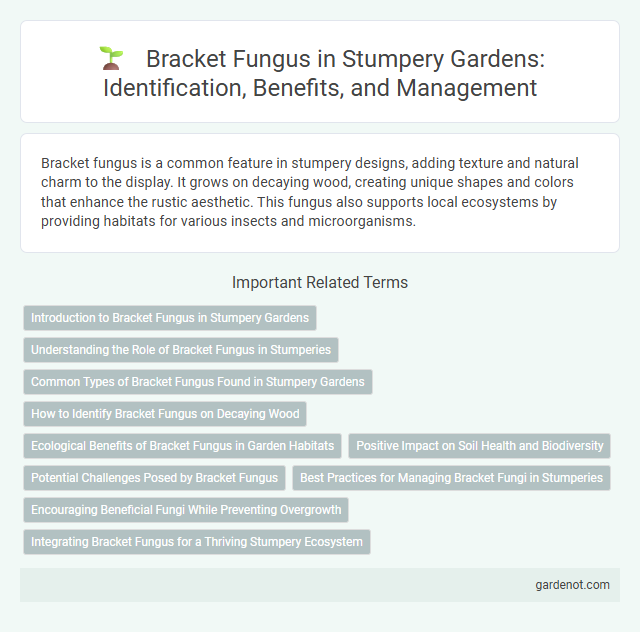Bracket fungus is a common feature in stumpery designs, adding texture and natural charm to the display. It grows on decaying wood, creating unique shapes and colors that enhance the rustic aesthetic. This fungus also supports local ecosystems by providing habitats for various insects and microorganisms.
Introduction to Bracket Fungus in Stumpery Gardens
Bracket fungi, also known as shelf fungi, play a vital role in stumpery gardens by decomposing dead wood and contributing to nutrient cycling. These fungi form distinctive, layered fruiting bodies that attach to tree stumps, logs, and decaying wood, creating unique textures and structures within the garden. Their presence enhances biodiversity and supports various insects and microorganisms crucial for a healthy stumpery ecosystem.
Understanding the Role of Bracket Fungus in Stumperies
Bracket fungus plays a crucial role in stumperies by accelerating wood decomposition and creating habitats for diverse invertebrates and microorganisms. Its presence enhances nutrient cycling within the decaying logs, supporting surrounding plant growth and maintaining ecosystem balance. Identifying species like Ganoderma and Trametes offers insight into the health and biodiversity of stumpery environments.
Common Types of Bracket Fungus Found in Stumpery Gardens
Common types of bracket fungus found in stumpery gardens include the artist's conk (Ganoderma applanatum), known for its hard, woody structure and distinctive white underside that darkens when scratched. The turkey tail (Trametes versicolor) displays vibrant, concentric color bands that enhance the visual appeal of decaying wood features. Shelf fungi such as the birch polypore (Fomitopsis betulina) are frequent in stumperies, contributing to natural decomposition while supporting diverse fungal biodiversity.
How to Identify Bracket Fungus on Decaying Wood
Bracket fungi, recognizable by their shelf-like, woody fruiting bodies, often grow in overlapping layers on decaying wood such as fallen trees or stumps. Look for distinct concentric rings and a tough, corky texture, with colors ranging from brown and grey to vibrant yellows and reds depending on the species. The underside typically features tiny pores rather than gills, which aid in spore release, making these features key identifiers for bracket fungus on decomposing wood.
Ecological Benefits of Bracket Fungus in Garden Habitats
Bracket fungus plays a crucial role in garden habitats by decomposing dead wood, recycling nutrients, and enriching soil fertility, which supports overall plant health. Its presence fosters biodiversity by providing food and shelter for insects, birds, and other wildlife, enhancing the ecological balance. These fungi also promote the breakdown of organic matter, contributing to carbon cycling and maintaining healthy ecosystem functions in garden environments.
Positive Impact on Soil Health and Biodiversity
Bracket fungus plays a crucial role in stumperies by decomposing wood and enriching soil with organic matter, enhancing nutrient cycling and soil fertility. Its mycelium networks promote soil structure and moisture retention, creating a favorable environment for diverse microorganisms and plant roots. The presence of bracket fungi increases biodiversity by supporting various insects, fungi, and small animals that rely on decaying wood habitats.
Potential Challenges Posed by Bracket Fungus
Bracket fungus can cause structural damage by decaying the wood it inhabits, weakening tree trunks and branches in a stumpery. The presence of bracket fungus accelerates the decomposition process, which may lead to instability in woodland features and increased maintenance requirements. Managing bracket fungus involves balancing its ecological benefits with the potential risks to plant health and garden safety.
Best Practices for Managing Bracket Fungi in Stumperies
Bracket fungi thrive on decaying wood in stumperies, requiring targeted management to maintain ecosystem balance. Regular inspection and selective removal of heavily infested stumps prevent structural damage while preserving beneficial fungal biodiversity. Employing controlled moisture and proper airflow further inhibits excessive bracket fungus growth, optimizing the health of the stumpery environment.
Encouraging Beneficial Fungi While Preventing Overgrowth
Bracket fungi play a vital role in decomposing dead wood, enriching soil nutrients and supporting forest ecosystems. Encouraging beneficial fungi involves maintaining diverse microhabitats and ensuring proper moisture levels to promote fungal growth without allowing harmful overgrowth. Monitoring fungal spread through regular inspection and removing excessive brackets helps balance ecological benefits with garden health.
Integrating Bracket Fungus for a Thriving Stumpery Ecosystem
Bracket fungus plays a vital role in a thriving stumpery ecosystem by decomposing dead wood and recycling nutrients back into the soil. Its symbiotic relationship with tree stumps promotes biodiversity, attracting insects and fungi that support various wildlife species. Integrating bracket fungus enhances soil health and accelerates organic matter breakdown, fostering a balanced and sustainable habitat within the stumpery.
Bracket fungus Infographic

 gardenot.com
gardenot.com